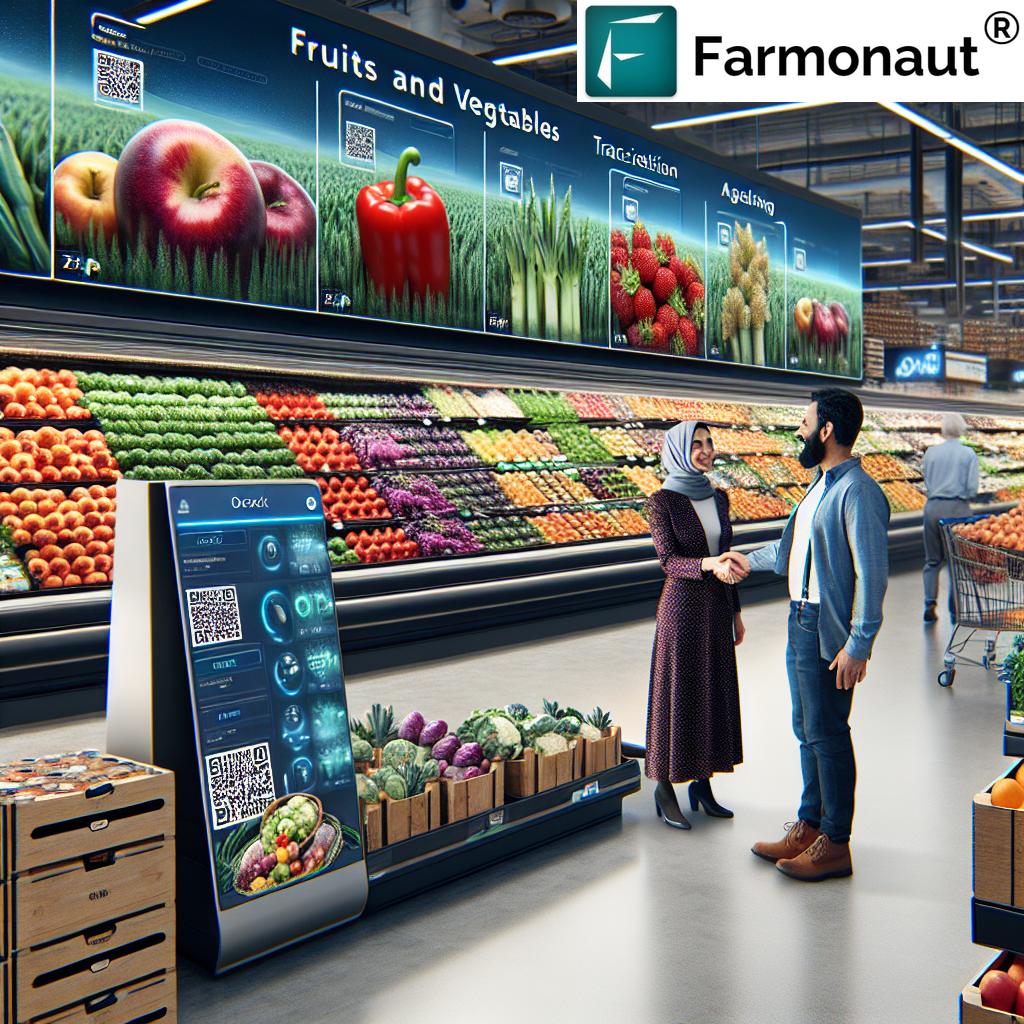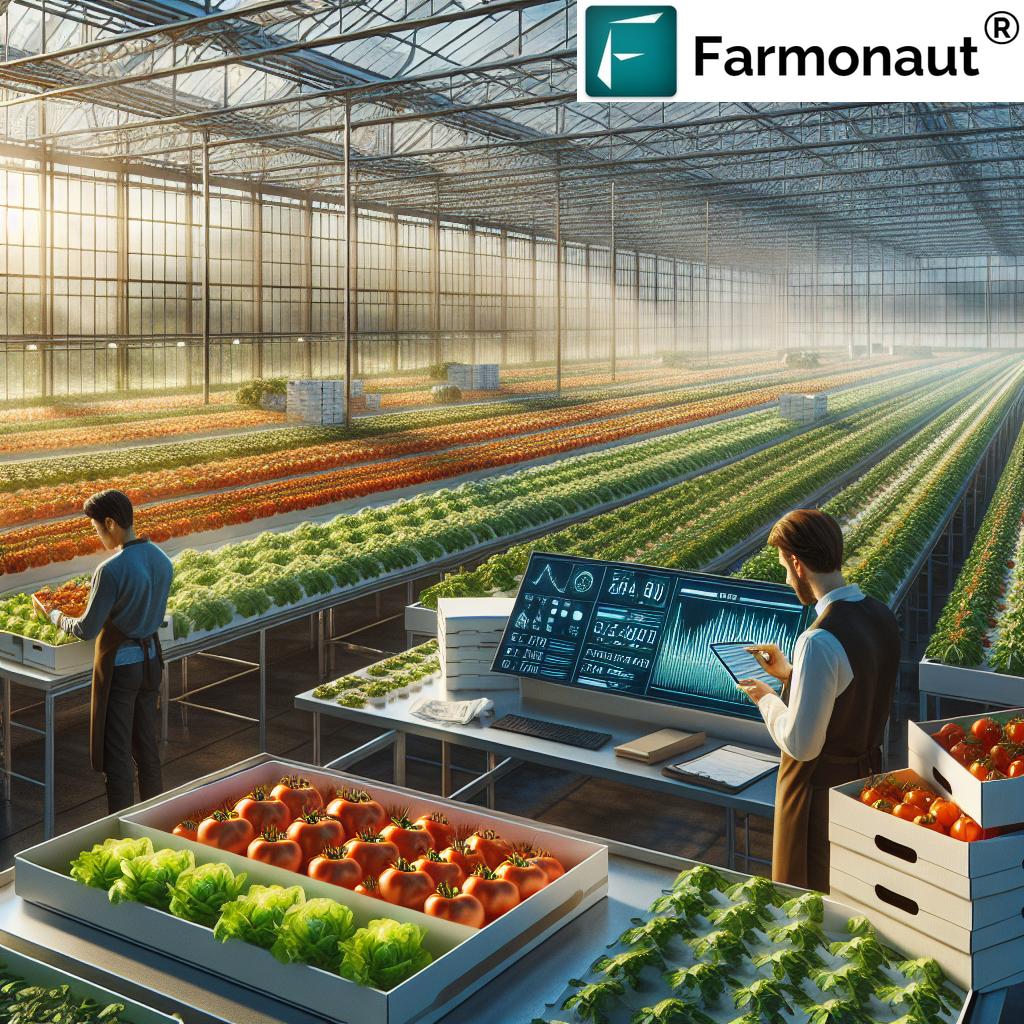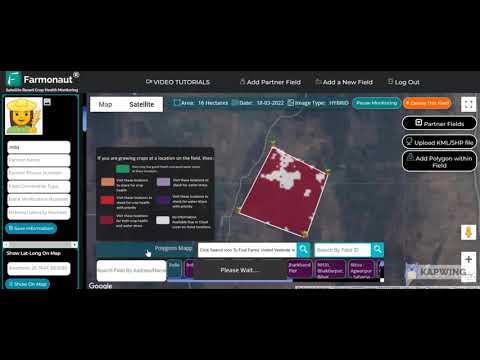Mastering Retail Culture: How Produce Suppliers Can Optimize Sales Strategies in 2024
“65% of produce suppliers struggle to align their fiscal calendars with diverse retail operational timelines.”

As we step into 2024, the landscape of retail culture in agriculture continues to evolve, presenting both challenges and opportunities for produce suppliers and growers. In this comprehensive guide, we’ll explore how to navigate the complex world of retailer-specific strategies, adapt to diverse retail environments, and optimize your sales approach in the ever-changing agricultural marketplace.
At Farmonaut, we understand the importance of staying ahead in the competitive world of agricultural sales. While we specialize in providing advanced satellite-based farm management solutions, we recognize that success in the produce industry extends beyond the field. That’s why we’ve compiled this insightful blog to help you master the art of retail culture and boost your sales strategies.
Understanding Retail Culture in Agriculture
Retail culture in agriculture refers to the unique set of practices, expectations, and operational norms that govern the relationship between produce suppliers and retailers. Each retailer has its own distinct culture, influenced by factors such as:
- Store size and format
- Target customer demographics
- Pricing strategies
- Merchandising preferences
- Promotional calendars
- Technological adoption
To succeed in this diverse landscape, suppliers must develop a deep understanding of these cultural nuances and tailor their approach accordingly. Let’s delve into the key aspects of mastering retail culture and optimizing your sales strategies for 2024.
Decoding Retail Terminology for Farmers
One of the first steps in navigating retail culture is understanding the language of the industry. Familiarizing yourself with common retail terminology will help you communicate more effectively with buyers and category managers. Here are some essential terms to know:
- Category Management: The process of managing product categories as strategic business units.
- Planogram: A visual representation of product placement on store shelves.
- SKU (Stock Keeping Unit): A unique identifier for each distinct product and product type in a store.
- Margin: The difference between the selling price and the cost of goods sold.
- Shrinkage: Loss of inventory due to factors such as theft, damage, or spoilage.
- Facings: The number of identical products displayed side-by-side on a shelf.
By mastering this terminology, you’ll be better equipped to engage in meaningful discussions with retailers and demonstrate your understanding of their business.
Supplier Strategies for Retailers: Tailoring Your Approach
Developing effective supplier strategies for retailers requires a nuanced understanding of each store’s unique culture and operational model. Here are some key strategies to consider:
- Customize your product offerings: Tailor your produce varieties and packaging to meet the specific needs of each retailer’s customer base.
- Align with promotional calendars: Sync your production and supply schedules with retailers’ promotional timelines to ensure consistent availability during key selling periods.
- Develop retailer-specific marketing materials: Create customized point-of-sale materials and promotional content that aligns with each retailer’s branding and marketing strategy.
- Offer flexible pricing structures: Implement volume discounts and promotional pricing that cater to different retailer sizes and sales volumes.
- Provide value-added services: Offer additional services such as category management insights or in-store product demonstrations to strengthen your partnership with retailers.
By implementing these strategies, you’ll position yourself as a valuable partner to retailers, rather than just another supplier.
Produce Marketing Techniques for Retail Success
Effective produce marketing techniques are crucial for capturing the attention of both retailers and consumers. Here are some strategies to enhance your marketing efforts:
- Storytelling: Develop compelling narratives around your farm, growing practices, and product quality to create an emotional connection with consumers.
- Seasonal promotions: Align your marketing efforts with seasonal trends and holidays to capitalize on peak demand periods.
- Cross-merchandising: Collaborate with retailers to create cross-promotional opportunities with complementary products (e.g., pairing avocados with tomatoes for guacamole).
- Social media engagement: Leverage platforms like Instagram and Pinterest to showcase your produce and share recipe ideas with consumers.
- Sustainability messaging: Highlight your environmentally friendly practices to appeal to eco-conscious consumers and retailers.
Remember, effective marketing goes beyond simply promoting your products; it’s about creating a compelling brand story that resonates with both retailers and end consumers.
Adapting to Diverse Retail Environments
Adapting to retail environments is crucial for produce suppliers looking to expand their market presence. Different retail formats require unique approaches:
- Supermarkets: Focus on consistent quality, competitive pricing, and efficient supply chain management.
- Specialty stores: Emphasize unique varieties, organic options, and local sourcing.
- Discount chains: Prioritize cost-efficiency and bulk packaging options.
- Online retailers: Develop packaging solutions that ensure freshness during shipping and provide digital content to support online sales.
- Farmers markets: Highlight your farm’s story and offer direct-to-consumer engagement opportunities.
By tailoring your approach to each retail environment, you can maximize your sales potential across diverse channels.
“Tailoring marketing strategies to individual store cultures can increase sales by up to 30% for agricultural suppliers.”
Optimizing Agricultural Supplier-Retailer Relationships
Building strong agricultural supplier-retailer relationships is fundamental to long-term success in the produce industry. Here are some tips for fostering positive partnerships:
- Consistent communication: Establish regular check-ins with buyers to discuss performance, upcoming promotions, and potential issues.
- Transparency: Be open about your production capabilities, potential challenges, and pricing structures.
- Reliability: Consistently meet delivery schedules and quality standards to build trust with retailers.
- Innovation: Proactively suggest new products or packaging ideas that align with retail trends.
- Problem-solving: When issues arise, focus on finding solutions rather than placing blame.
By prioritizing these relationship-building strategies, you’ll position yourself as a preferred supplier in the eyes of retailers.

Produce Merchandising Best Practices
Effective produce merchandising can significantly impact sales performance. Here are some best practices to consider:
- Eye-catching displays: Create visually appealing product arrangements that draw customers’ attention.
- Proper rotation: Implement first-in, first-out (FIFO) rotation to maintain freshness and reduce waste.
- Cross-merchandising: Place complementary items together to encourage additional purchases.
- Educational signage: Provide information on product origins, nutritional benefits, and usage ideas.
- Sampling programs: Offer taste tests to introduce customers to new varieties or less familiar produce items.
By working closely with retailers to implement these merchandising strategies, you can help drive sales and reduce shrinkage.
Retailer-Specific Promotional Planning
Retailer-specific promotional planning is essential for aligning your supply with each store’s unique marketing calendar. Consider the following aspects when developing your promotional strategy:
- Timing: Coordinate with retailers to plan promotions during peak seasonality and high-traffic periods.
- Volume forecasting: Work with buyers to accurately predict promotional lift and ensure sufficient supply.
- Pricing strategy: Develop tiered pricing options that allow for attractive promotional offers while maintaining profitability.
- Marketing support: Provide retailers with high-quality images, recipe cards, and other promotional materials to support their marketing efforts.
- Post-promotion analysis: Conduct thorough reviews of promotional performance to refine future strategies.
By mastering the art of promotional planning, you can drive sales volume and strengthen your position as a valuable supplier partner.
Aligning Fiscal Calendars and Volume Discounts
One of the challenges in mastering retail culture is aligning your business operations with diverse retailer fiscal calendars. Here’s how to navigate this complexity:
- Understand retailer fiscal years: Familiarize yourself with each retailer’s fiscal calendar to better plan promotions and volume commitments.
- Flexible contract terms: Develop agreements that can accommodate different fiscal year-ends and budget cycles.
- Volume discount structures: Create tiered volume discount programs that align with retailers’ purchasing patterns and fiscal planning.
- Regular review cycles: Implement quarterly or bi-annual review processes to assess performance and adjust strategies as needed.
By aligning your business practices with retailers’ fiscal calendars, you can create more effective long-term partnerships and optimize your sales strategies.
Leveraging Agtech Solutions for Retail Partnerships
Agtech solutions for retail partnerships can provide valuable data and insights to strengthen your relationships with retailers. While Farmonaut specializes in satellite-based farm management solutions, there are various technologies that can benefit supplier-retailer relationships:
- Supply chain visibility tools: Implement systems that provide real-time tracking of product from farm to store.
- Demand forecasting software: Utilize AI-driven platforms to predict consumer demand and optimize inventory levels.
- Quality control technologies: Employ advanced imaging and sensor technologies to ensure consistent product quality.
- Blockchain traceability: Consider implementing blockchain solutions to provide transparent, end-to-end traceability for your products.
By leveraging these technologies, you can provide added value to retailers and differentiate yourself in the competitive produce market.
For farmers looking to optimize their crop management and boost productivity, Farmonaut offers advanced satellite-based solutions. Our platform provides valuable insights into crop health, weather patterns, and resource management, helping you make data-driven decisions that can improve your overall yield and quality.
Explore Farmonaut’s solutions:
Optimizing In-Store Specials and Promotions
Effective management of in-store specials and promotions is crucial for driving sales and building brand loyalty. Consider these strategies:
- Seasonal promotions: Align your promotional calendar with key seasons and holidays to capitalize on peak demand periods.
- Bundle deals: Create attractive multi-product offers that encourage larger purchases and introduce customers to new items.
- Limited-time offers: Use scarcity tactics to create a sense of urgency and drive immediate sales.
- Loyalty program integration: Work with retailers to incorporate your products into their customer loyalty programs for added visibility and sales incentives.
- Digital coupon strategies: Develop targeted digital coupon campaigns to reach tech-savvy consumers and drive in-store traffic.
By collaborating closely with retailers on these promotional strategies, you can maximize the impact of in-store specials and drive sustainable sales growth.
Adapting Agricultural Sales Strategies for 2024
As we look ahead to 2024, it’s crucial to adapt your agricultural sales strategies to meet evolving market demands. Here are some key trends and strategies to consider:
- Sustainability focus: Emphasize your sustainable farming practices and explore opportunities for regenerative agriculture partnerships with retailers.
- Local sourcing: Capitalize on the growing demand for locally sourced produce by highlighting your farm’s proximity to retail locations.
- Plant-based trends: Explore opportunities to expand your product line to include plant-based alternatives or ingredients popular in plant-based diets.
- E-commerce integration: Develop strategies to support retailers’ online sales channels, including appropriate packaging and fulfillment solutions.
- Data-driven decision making: Leverage analytics tools to gain deeper insights into consumer preferences and purchasing patterns.
By staying ahead of these trends and continuously adapting your strategies, you can position your business for long-term success in the retail produce market.
Retailer-Specific Produce Sales Strategies Comparison
| Retailer Type | Promotional Planning Timeline | Preferred Merchandising Tactics | Fiscal Calendar Alignment | Volume Discount Structure | In-Store Special Frequency | Agtech Solution Compatibility |
|---|---|---|---|---|---|---|
| Supermarket | 3-6 months advance | End-cap displays, cross-merchandising | Typically Jan-Dec fiscal year | Tiered based on annual volume | Weekly rotations | High – inventory management, demand forecasting |
| Organic Specialty Store | 1-3 months advance | Storytelling, farm-to-table messaging | Varies, often Jul-Jun fiscal year | Emphasis on quality over volume | Monthly themes | Medium – traceability, quality assurance |
| Discount Chain | 6-12 months advance | Bulk displays, price-focused signage | Often Feb-Jan fiscal year | Aggressive volume-based discounts | Bi-weekly specials | Low – focus on cost efficiency |
| Online Retailer | 1-2 months advance | Digital content, recipe integration | Typically aligned with calendar year | Dynamic pricing based on demand | Flash sales, daily deals | Very High – AI-driven forecasting, logistics optimization |
Conclusion: Mastering Retail Culture for Produce Success
As we’ve explored throughout this guide, mastering retail culture is essential for produce suppliers looking to optimize their sales strategies in 2024 and beyond. By understanding the nuances of different retail environments, tailoring your approach to each retailer’s unique culture, and leveraging innovative technologies and marketing techniques, you can position your business for long-term success in the competitive produce market.
Remember that success in retail partnerships requires constant adaptation and a commitment to continuous improvement. Stay attuned to market trends, maintain open lines of communication with your retail partners, and be willing to innovate in response to changing consumer demands.
At Farmonaut, we’re committed to supporting farmers and produce suppliers with cutting-edge satellite-based farm management solutions. While our focus is on optimizing crop production through advanced technology, we understand that success in agriculture extends from the field to the retail shelf. By combining effective retail strategies with data-driven farm management, you can create a powerful foundation for sustainable growth and profitability in the agricultural sector.
FAQ: Mastering Retail Culture for Produce Suppliers
Q: How can I better understand a retailer’s specific culture?
A: Research the retailer’s history, target demographic, and marketing strategies. Visit their stores, analyze their product mix, and engage in conversations with their buyers to gain deeper insights into their operational culture.
Q: What are some effective ways to differentiate my products in a crowded retail environment?
A: Focus on unique varieties, sustainable farming practices, local sourcing, or innovative packaging. Develop compelling brand storytelling and consider value-added services like category management insights or in-store demonstrations.
Q: How can I improve my promotional planning with retailers?
A: Align your production schedules with retailers’ promotional calendars, provide accurate volume forecasts, and offer flexible pricing options. Collaborate on marketing materials and conduct post-promotion analyses to refine future strategies.
Q: What role does technology play in optimizing retail partnerships?
A: Technology can enhance supply chain visibility, improve demand forecasting, ensure consistent quality, and provide traceability. Consider implementing solutions that complement retailers’ existing systems and provide valuable data insights.
Q: How can I adapt my sales strategies for different types of retailers?
A: Tailor your approach based on each retailer’s format, target audience, and operational model. For example, focus on bulk options and cost efficiency for discount chains, while emphasizing unique varieties and storytelling for specialty stores.
By implementing the strategies and insights shared in this guide, you’ll be well-equipped to navigate the complex world of retail culture and optimize your sales strategies as a produce supplier in 2024 and beyond. Remember, success in the retail produce market is an ongoing journey of adaptation, innovation, and relationship-building.
For more information on how Farmonaut’s satellite-based farm management solutions can help optimize your crop production and support your retail strategies, visit our web app or explore our API for advanced data integration. You can also find detailed information in our API Developer Docs.






